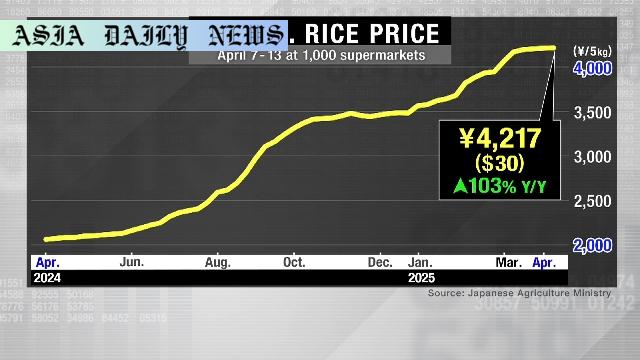Rice Prices – Japan’s supermarkets witness 15th consecutive week of rice price hikes despite government efforts to stabilize prices.
The retail price of rice in Japan has increased for the 15th consecutive week.
Government efforts like stockpile releases have had limited impact.
Experts forecast that the upward trend may stabilize soon.

Introduction to the Issue of Rising Rice Prices
Over the past 15 weeks, rice prices in Japan have experienced an uninterrupted upward trajectory, presenting challenges for both consumers and the agricultural economy. Despite efforts from the government to manage this inflation through strategic interventions, including the release of national stockpiles, the effectiveness of these measures appears limited. The average retail price for a 5-kilogram bag of rice stands at 4,217 yen, equivalent to approximately 30 USD, reflecting a stark increase compared to the same period last year.
Government Interventions and Limited Outcomes
In efforts to curb inflation, the Japanese government conducted its first auction in March, releasing over 140,000 tons of rice from national reserves. However, only a mere fraction — approximately 0.3% — of this stockpile actually reached supermarket shelves by the end of the month. This highlights logistical inefficiencies and the time lag associated with a strategy intended to stabilize market supply and demand dynamics.
Expert Analysis and Price Stabilization Predictions
According to Orikasa Shunsuke, Principal Researcher at the Distribution Economics Institute of Japan, the continuation of rice price hikes is unlikely. Market indicators suggest that the wholesale prices recorded in March showed a decline from previous months, signifying a potential price correction. Projections from experts indicate that the average retail price of a 5-kilogram bag could decrease to 3,500 yen (around 25 USD) by the summer months, offering much-needed relief to consumers.
Future Outlook and Government’s Strategic Roadmap
The Japanese government plans to sustain monthly stockpile releases throughout the summer in an attempt to alleviate the burden on households. However, the success of this initiative will depend on swift distribution logistics and efficient coordination with retail chains. Ensuring supply chain transparency and consumer accessibility to the released reserves remains a core challenge that needs to be addressed to mitigate the economic strain on Japanese households effectively.
Implications for Consumers and Broader Economy
As household budgets tighten, the rising price of a staple food like rice could lead to significant shifts in consumer spending patterns. This may also catalyze broader conversations around food security and the sustainability of national agriculture practices. Policymakers, economists, and agricultural stakeholders must work collaboratively to ensure long-term solutions that balance market demands with affordable pricing models for essential commodities.



Commentary
The Social Impact of Rising Rice Prices
The surge in rice prices in Japan highlights the far-reaching implications of supply chain disruptions and inflationary pressures on essential commodities. For consumers, particularly those in low to middle-income brackets, this trend compounds the financial strain caused by the broader economic challenges. A seemingly minor increase in the price of a staple food can ripple through household budgets, forcing difficult trade-offs in other areas of spending.
The Role of Strategic Policy and Market Dynamics
The Japanese government’s decision to release national rice stockpiles underscores the critical role that public intervention plays in stabilizing essential goods during times of market volatility. However, the limited impact of these measures so far points to the complexity of managing supply chain logistics and ensuring that policy efforts translate effectively into market relief. It raises a pertinent question: should governments invest more heavily in enhancing distribution mechanisms alongside stockpile strategies?
Opportunities for Innovation and Collaboration
Moving forward, there is an opportunity for innovation in both agricultural practices and supply chain management to mitigate such crises in the future. Partnerships between the public and private sectors could lead to the development of smarter distribution systems, while advancements in agricultural technology could improve crop yields and resilience against economic shocks. By embracing such collaborative approaches, Japan could create a more stable and resilient food economy.
A Call for Collaborative Efforts
Ultimately, the steady rise of rice prices serves as a reminder of the interconnectedness of supply chains, consumer behavior, and governmental policies. As this issue unfolds, it will be critical for all stakeholders involved — from policymakers to farmers and retailers — to collaborate and implement measures that uphold economic stability while ensuring food affordability for all citizens. These challenges highlight the importance of proactive, inclusive, and forward-thinking governance to navigate a path out of such economic pressures.